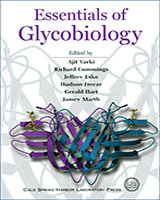NCBI Bookshelf. A service of the National Library of Medicine, National Institutes of Health.
Varki A, Cummings R, Esko J, et al., editors. Essentials of Glycobiology. Cold Spring Harbor (NY): Cold Spring Harbor Laboratory Press; 1999.

Essentials of Glycobiology.
Show detailsThe ESSENTIALS OF GLYCOBIOLOGY could not appear at a more opportune time, for the field is in a period of enormous progress and the prospects for future advances are even greater. Glycobiology has its roots in the nineteenth century, when chemists first began to analyze sugars and polysaccharides. Perhaps the first glycoprotein to be studied was the “glycogenous matter” of liver which the famous French physiologist Claude Bernard identified in 1855 as a storage form of glucose. (Interestingly, the evidence that glycogen is a glycoprotein was not obtained until more than 100 years later.) Advances in this area continued at a steady rate during most of this century, but the past 20 years has witnessed an unparalleled explosion of new knowledge that has transformed the field. There are many reasons for this acceleration of progress, including great technical advances in establishing oligosaccharide structures, but by far the most important is the application of recombinant DNA technology to the field. This has resulted in the molecular characterization of the enzymes involved in the assembly, processing, and degradation of oligosaccharides and proteoglycans. It has also allowed the identification of numerous families of plant and animal lectins that recognize carbohydrate structures. The surprising finding to emerge is the vast number of enzymes and proteins that are devoted to glycoprotein and glycolipid synthesis and function. The understanding of the biologic roles of glycans has also increased to a great extent, and we now know that these molecules serve multiple functions, ranging from assisting the folding of nascent proteins to determining the trafficking of lymphocytes and granulocytes in the circulation. The important role of glycans is underscored by the growing list of human diseases that are the result of defects in glycan assembly. The challenge for the future is to further define the biologic functions played by glycans. In this regard, recombinant DNA technology has provided another valuable tool for the glycobiologist: the ability to disrupt genes of interest in mice and other organisms. This presents an unparalleled opportunity for the scientist interested in elucidating the biologic roles of sugars. Without a doubt, the future in this area is the brightest it has ever been.
Essentials of Glycobiology provides an ideal entry into the field. It contains the basic information needed to understand this area along with the most current work at the forefront of the field. The authors are to be commended for assembling a broad, comprehensive, well-organized overview of this burgeoning field. They have also been successful in conveying the excitement in this area of research.
Stuart Kornfeld
Washington University School of Medicine
March 1999
- Foreword - Essentials of GlycobiologyForeword - Essentials of Glycobiology
- Lepiotaceae sp. PA681 internal transcribed spacer 1, partial sequence; 5.8S ribo...Lepiotaceae sp. PA681 internal transcribed spacer 1, partial sequence; 5.8S ribosomal RNA gene, complete sequence; and internal transcribed spacer 2, partial sequencegi|140104638|gb|EF527398.1|Nucleotide
Your browsing activity is empty.
Activity recording is turned off.
See more...
